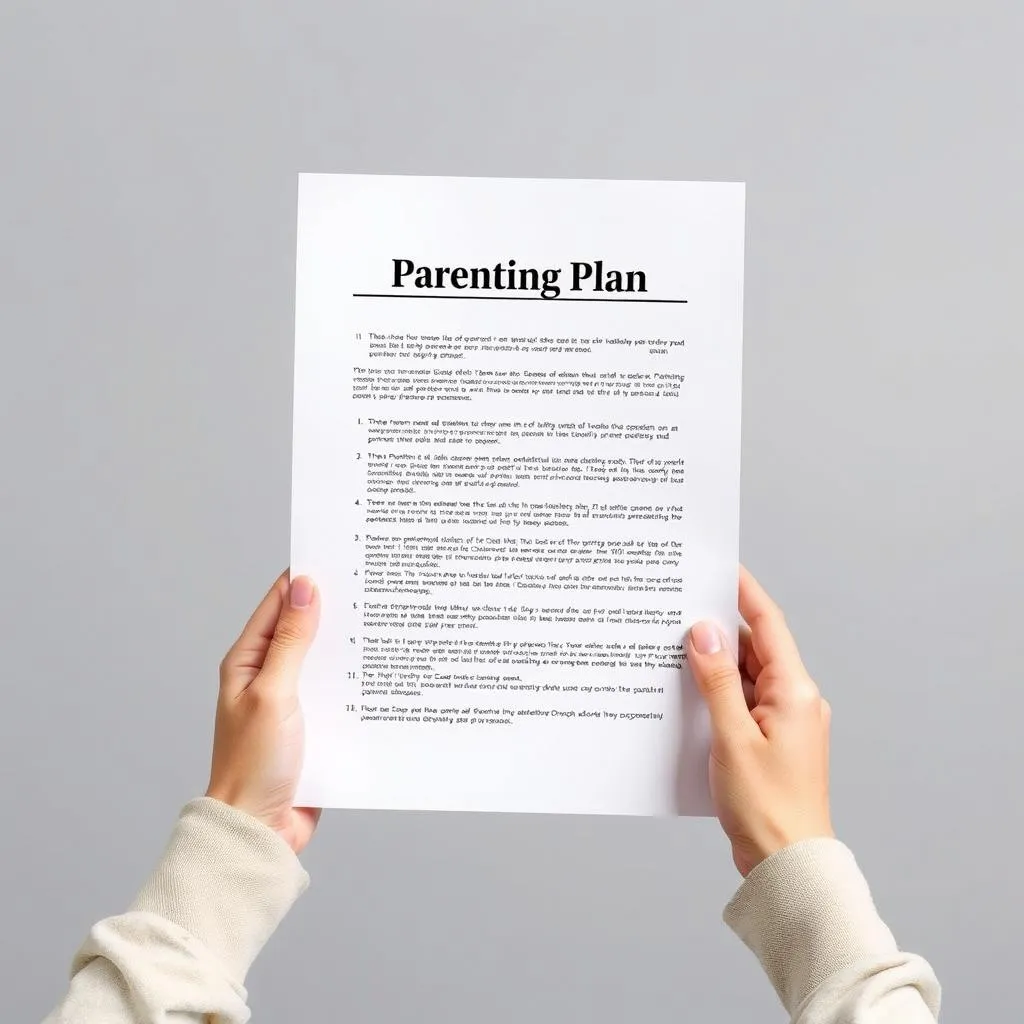8 Strategies for Dividing Parenting Responsibilities Fairly

Introduction
Parenting after divorce: A new challenge
Are you feeling overwhelmed by parenting after divorce? You’re not alone. Many parents struggle to find their footing in this new reality. But here’s some good news: working together can make a big difference.
A recent study found something interesting. Children of divorced parents who share responsibilities equally tend to:
- Adjust better emotionally
- Perform better in school
This shows just how important it is to divide parenting duties fairly.
8 strategies for better co-parenting
In this article, we’ll explore 8 practical ways to balance parenting responsibilities with your ex-partner. These strategies will:
- Make your life easier
- Create a stable environment for your kids
Here’s what we’ll cover:
- Creating a detailed parenting plan
- Using a shared calendar system
- Dividing tasks based on strengths and availability
- Regular communication check-ins
- Being flexible and compromising
- Using the 2-2-5-5 schedule or similar arrangements
- Establishing clear financial responsibilities
- Seeking professional help when needed
By following these strategies, you can build a strong co-parenting relationship that benefits everyone, especially your children.
Ready to dive in? Let’s start with our first strategy!
Understanding the Importance of Fair Parenting Division

Why fair division matters
Splitting parenting responsibilities evenly isn’t just about being fair to each other. It’s about creating the best possible environment for your children. Let’s look at why this is so important:
Benefits for children
When parents divide responsibilities fairly, children often experience:
- Better emotional stability
- Improved sense of security
- Stronger relationships with both parents
- Less stress and anxiety
- Higher self-esteem
Reduced conflict between parents
Fair division of duties can lead to:
- Fewer arguments about responsibilities
- Less resentment between parents
- More peaceful interactions when you meet
This reduced tension doesn’t go unnoticed by kids. They feel more comfortable and secure when their parents get along.
Improved co-parenting relationship
Working together to divide tasks fairly can:
- Build trust between you and your ex-partner
- Improve communication skills
- Create a more positive family atmosphere
When you have a good co-parenting relationship, it’s easier to make decisions together and support each other in raising your children.
Remember, fair doesn’t always mean equal. It’s about finding a balance that works for everyone involved, especially your kids.
Strategy 1: Create a Detailed Parenting Plan

What is a parenting plan?
A parenting plan is a written agreement that outlines how you and your ex-partner will raise your children together. It’s like a roadmap for your co-parenting journey.
Key components to include
A good parenting plan should cover:
- Custody schedule
- Holiday and vacation arrangements
- Decision-making process for important issues
- Communication methods and frequency
- Rules for introducing new partners
- Financial responsibilities
- Conflict resolution strategies
Tips for creating an effective plan
- Be specific: The more detailed your plan, the less room for misunderstandings.
- Focus on your children’s needs: Put your kids’ well-being at the center of every decision.
- Be realistic: Consider work schedules, living arrangements, and other commitments.
- Plan for changes: Include a process for reviewing and updating the plan as your children grow.
- Seek professional help: A mediator or family lawyer can guide you through this process.
- Keep it flexible: While structure is important, allow room for unexpected situations.
Remember, a parenting plan is not set in stone. It’s a living document that can and should be adjusted as your family’s needs change.
Creating a detailed parenting plan might seem overwhelming at first, but it’s a powerful tool for reducing conflict and ensuring your children’s needs are met consistently.
Strategy 2: Utilize a Shared Calendar System
Digital calendars: A co-parenting game-changer
In today’s digital age, shared calendars can be a lifesaver for co-parents. They help you:
- Keep track of schedules
- Avoid miscommunication
- Plan ahead more effectively
Benefits of shared calendars
- Real-time updates: Both parents can see changes instantly.
- Reduced conflicts: Fewer scheduling mix-ups mean fewer arguments.
- Better organization: All important dates in one place.
- Improved communication: Less need for frequent check-ins about schedules.
Recommended apps and tools
Here are some popular options:
- Google Calendar
- OurFamilyWizard
- 2Houses
- Cozi Family Organizer
Using shared calendars effectively
- Color-code events: Use different colors for each parent, child, or type of activity.
- Set reminders: Add alerts for important events like doctor’s appointments or school activities.
- Include all details: Note pickup times, locations, and any special instructions.
- Respect boundaries: Don’t make changes without discussing them first.
- Sync with personal calendars: Ensure you don’t double-book yourself.
Remember, a shared calendar is a tool to make co-parenting easier, not a replacement for clear communication. Use it alongside regular check-ins for the best results.
By embracing this digital solution, you’re taking a big step towards smoother, more organized co-parenting. It might take some getting used to, but many parents find it invaluable once they’ve established the habit.
Strategy 3: Divide Responsibilities Based on Strengths and Availability

Playing to your parenting strengths
Every parent has unique skills and abilities. By dividing tasks based on what each of you does best, you can:
- Ensure tasks are done well
- Reduce stress and frustration
- Make the most of your individual talents
Assessing strengths and weaknesses
Take some time to consider:
- What activities do you enjoy with your children?
- What tasks do you handle efficiently?
- Where do you struggle or feel less confident?
Be honest with yourself and your co-parent. It’s okay to admit areas where you’re not as strong.
Considering schedules and commitments
Factor in:
- Work hours
- Commute times
- Other family obligations
A fair division doesn’t always mean a 50/50 split of time. It means finding a balance that works for everyone.
Creating a fair division of tasks
Here’s a simple table to help you get started:
| Task | Parent A | Parent B |
|---|---|---|
| School drop-off | ✓ | |
| School pick-up | ✓ | |
| Doctor appointments | ✓ | |
| Extracurricular activities | ✓ | |
| Homework help | ✓ | |
| Bedtime routine | ✓ |
Remember, this table is just an example. Your division of tasks should reflect your unique situation.
Tips for success
- Be flexible: Strengths and schedules can change over time.
- Communicate regularly: Check in about how the division is working.
- Be willing to learn: If one parent has a strength, they can teach the other.
- Focus on the kids: The goal is to provide the best care for your children.
By dividing responsibilities based on strengths and availability, you’re setting up a system that plays to each parent’s advantages. This can lead to more efficient parenting and happier kids.
Strategy 4: Implement Regular Communication Check-ins

Keeping the lines open
Regular check-ins are crucial for successful co-parenting. They help you:
- Stay on the same page
- Address issues before they become problems
- Make joint decisions more easily
Why ongoing communication matters
Consistent communication:
- Reduces misunderstandings
- Keeps both parents involved and informed
- Shows children that their parents are working together
Suggested frequency and format
- Weekly: A brief phone call or video chat to discuss the coming week
- Monthly: A longer, in-person meeting to address bigger issues
- As needed: Quick text messages for day-to-day updates
Choose a format that works for both of you. The key is consistency.
Topics to discuss during check-ins
- Children’s health and well-being
- School performance and any concerns
- Upcoming events or schedule changes
- Discipline issues and how to handle them
- Financial matters related to the children
- Any changes in personal circumstances that might affect the children
Tips for effective check-ins
- Set a regular time: Make it a habit, like every Sunday evening.
- Stick to the point: Focus on parenting issues, not personal matters.
- Listen actively: Try to understand your co-parent’s perspective.
- Stay calm: If tensions rise, take a break and resume later.
- Take notes: Write down important points and decisions made.
- End positively: Acknowledge what’s working well in your co-parenting.
Remember, these check-ins are about your children, not about rehashing past relationship issues. Keep the focus on parenting and your kids’ needs.
By implementing regular communication check-ins, you’re building a strong foundation for effective co-parenting. It might feel awkward at first, but with time, it can become a valuable tool in your co-parenting toolkit.
Strategy 5: Be Flexible and Willing to Compromise
Embracing flexibility in co-parenting
Life is unpredictable, especially when raising children. Being flexible and open to compromise can:
- Reduce stress for everyone involved
- Model problem-solving skills for your children
- Improve your co-parenting relationship
Understanding the need for flexibility
Rigid schedules and inflexible rules often lead to:
- Increased conflict between parents
- Stress for children
- Missed opportunities for quality family time
Examples of situations requiring compromise
- Work schedule changes: A parent gets a new job with different hours
- Family emergencies: A grandparent falls ill and needs care
- Special events: A once-in-a-lifetime opportunity for a child
- Health issues: A child or parent becomes sick
- Holidays: Balancing time with extended family
Tips for effective negotiation and problem-solving
- Focus on the children’s needs: Ask, “What’s best for our kids in this situation?”
- Listen actively: Try to understand your co-parent’s perspective fully before responding.
- Propose solutions: Offer ideas that could work for both parties.
- Be willing to give and take: If you’re flexible this time, your co-parent may be more likely to reciprocate in the future.
- Keep emotions in check: Stay calm and rational, even if discussions become tense.
- Document agreements: Write down any changes to avoid misunderstandings later.
- Be proactive: Anticipate potential issues and discuss them in advance when possible.
Remember, flexibility doesn’t mean always saying yes. It’s about finding solutions that work for everyone while prioritizing your children’s well-being.
By being flexible and willing to compromise, you’re creating a more harmonious co-parenting environment. This approach can lead to less stress for you and a more stable, adaptable environment for your children.
Strategy 6: Use the 2-2-5-5 Schedule or Similar Arrangements
Understanding the 2-2-5-5 schedule
The 2-2-5-5 schedule is a popular co-parenting arrangement that provides consistency and balance. Here’s how it typically works:
- Parent A has the children for 2 days
- Parent B has the children for 2 days
- Parent A has the children for 5 days
- Parent B has the children for 5 days
- The cycle then repeats
Benefits of this arrangement
- Consistent routine: Children know what to expect each week
- Equal parenting time: Both parents get weekday and weekend time
- Longer stretches: 5-day periods allow for extended quality time
- Flexibility: Can be adjusted for work schedules
Implementing the 2-2-5-5 schedule
- Decide on transition days (e.g., Monday and Friday)
- Create a shared calendar to track the schedule
- Plan for holidays and special occasions separately
Other potential scheduling options
While the 2-2-5-5 works for many families, it’s not the only option. Consider these alternatives:
- Week on/Week off: Children spend one week with each parent
- 3-4-4-3: Similar to 2-2-5-5 but with slightly different day splits
- 2-2-3: A more frequent exchange suitable for younger children
- Nesting: Children stay in the family home, parents rotate in and out
Choosing the right schedule
Consider these factors:
- Children’s ages and needs
- Parents’ work schedules
- Distance between homes
- Children’s school and activity schedules
Remember, the best schedule is one that works for your unique family situation. Be open to trying different arrangements and adjusting as needed.
By using a structured schedule like the 2-2-5-5 or a similar arrangement, you’re providing stability and predictability for your children while ensuring both parents have meaningful time with them.
Strategy 7: Establish Clear Financial Responsibilities

Money matters in co-parenting
Handling finances is often a challenging aspect of co-parenting. Clear financial agreements can:
- Reduce conflicts
- Ensure children’s needs are met
- Provide stability for the whole family
Why financial clarity is crucial
Unclear financial arrangements can lead to:
- Arguments between parents
- Stress for children
- Unmet needs or missed opportunities
Areas to consider
- Basic expenses: Food, clothing, shelter
- Education costs: Tuition, books, supplies
- Healthcare: Insurance, medications, doctor visits
- Extracurricular activities: Sports, music lessons, clubs
- Special occasions: Birthdays, holidays, graduations
- Future planning: College savings, trust funds
Tips for creating a fair financial arrangement
- Be transparent: Share all relevant financial information.
- Use percentages: Consider splitting costs based on income percentages rather than fixed amounts.
- Create a shared account: For joint expenses related to the children.
- Keep records: Document all child-related expenses.
- Review regularly: Reassess the arrangement annually or when circumstances change.
- Plan for the unexpected: Discuss how to handle unforeseen expenses.
- Consider mediation: If you’re struggling to agree, a financial mediator can help.
Sample financial division table
| Expense Type | Parent A | Parent B |
|---|---|---|
| School Tuition | 60% | 40% |
| Medical Bills | 50% | 50% |
| Extracurriculars | 100% | Provides transportation |
| Clothing | When with A | When with B |
Remember, this is just an example. Your arrangement should reflect your specific situation and be fair to both parents while prioritizing the children’s needs.
By establishing clear financial responsibilities, you’re creating a stable economic environment for your children and reducing potential conflicts with your co-parent.
Strategy 8: Seek Professional Help When Needed

It’s okay to ask for help
Co-parenting can be challenging, and sometimes you might need outside support. Seeking professional help:
- Is a sign of strength, not weakness
- Can provide valuable insights and tools
- May prevent small issues from becoming big problems
Benefits of co-parenting counseling or mediation
- Improved communication: Learn effective ways to talk with your co-parent
- Conflict resolution: Develop skills to handle disagreements constructively
- Child-focused decisions: Get guidance on putting your children’s needs first
- Neutral perspective: Gain insights from an unbiased third party
When to consider professional help
- You’re struggling to communicate effectively
- Conflicts are frequent or intense
- You’re having trouble agreeing on important decisions
- Your children are showing signs of stress or behavioral issues
- You want to improve your co-parenting relationship
Types of professionals who can assist
- Co-parenting counselors: Specialize in helping divorced or separated parents work together
- Family therapists: Can work with the whole family to improve relationships
- Mediators: Help resolve specific disputes and create agreements
- Parenting coordinators: Assist with day-to-day parenting issues and decision-making
Choosing the right professional
- Look for someone with experience in co-parenting issues
- Ensure they’re licensed and have good reviews
- Consider whether you need short-term help or ongoing support
- Discuss the process and goals before committing
Remember, seeking help doesn’t mean you’ve failed. It means you’re committed to being the best co-parents possible for your children.
Tips for successful professional intervention
- Be open-minded: Try to consider new perspectives and ideas
- Do the work: Apply what you learn between sessions
- Stay focused on the children: Keep their well-being as the primary goal
- Be honest: Share your true feelings and concerns for the best results
By being willing to seek professional help when needed, you’re demonstrating your commitment to effective co-parenting and your children’s well-being.
Conclusion

Bringing it all together
Co-parenting after divorce or separation is a journey, not a destination. By implementing these 8 strategies, you’re setting the stage for a more harmonious and effective co-parenting relationship:
- Creating a detailed parenting plan
- Using a shared calendar system
- Dividing responsibilities based on strengths and availability
- Implementing regular communication check-ins
- Being flexible and willing to compromise
- Using the 2-2-5-5 schedule or similar arrangements
- Establishing clear financial responsibilities
- Seeking professional help when needed
Remember, the goal is not perfection, but progress. Every step you take towards better co-parenting benefits your children immensely.
The positive impact on children
When parents work together effectively:
- Children feel more secure and stable
- They experience less stress and anxiety
- Their emotional and academic development improves
- They learn valuable lessons about cooperation and problem-solving
A final word of encouragement
Co-parenting isn’t always easy, but it’s incredibly rewarding. By putting your children’s needs first and working together with your co-parent, you’re giving your kids the best possible foundation for a happy, healthy future.
Stay patient, keep communicating, and don’t hesitate to adjust your approach as needed. With time and effort, you can create a positive co-parenting relationship that benefits everyone involved, especially your children.
Remember, you’re not just parenting – you’re shaping the future. Your efforts today will have a lasting impact on your children’s lives.
Additional Resources
To further support your co-parenting journey, here are some valuable resources:
Recommended books on co-parenting:
- Co-parenting with a Toxic Ex – Offers strategies for dealing with challenging co-parenting situations.
- The Co-Parenting Handbook – Provides practical advice for raising well-adjusted children in two homes.
- Parallel Parenting – Explores an alternative approach for high-conflict situations.
Useful websites and online tools:
- OurFamilyWizard – A comprehensive co-parenting communication and scheduling platform.
- Custody X Change – Helps create detailed parenting plans and custody schedules.
- Cozi – A family organizer app that can be adapted for co-parenting use.
Organizations offering support:
- AFCC (Association of Family and Conciliation Courts) – Provides resources and research on family law and co-parenting.
- Up to Parents – Offers free co-parenting classes and resources.
- National Parents Organization – Advocates for shared parenting and provides educational resources.
Local support groups:
To find local support groups, consider:
- Checking with your local family court for recommendations
- Asking your family therapist or mediator about group sessions
- Searching Meetup for co-parenting groups in your area
- Contacting nearby community centers or religious organizations
Remember, every co-parenting journey is unique. Explore these resources to find what works best for your situation and don’t hesitate to seek professional guidance when needed.
